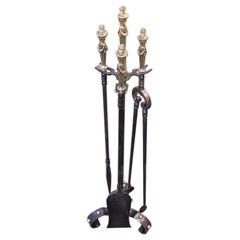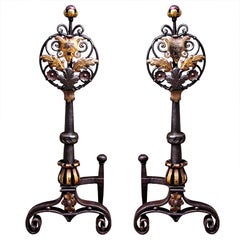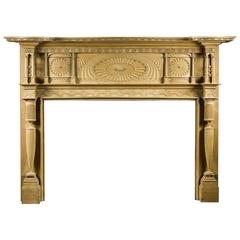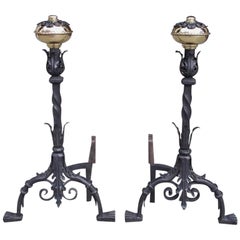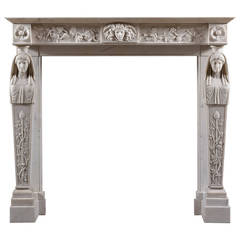1810s Fireplaces and Mantels
4
to
4
4
4
4
13
6
4
1
38
200
42
7
12
7
13
2
1
2
4
1
12
Height
to
Width
to
2
2
2
1
1
3
3
1
1
Style: Neoclassical
Period: 1810s
Set of Italian Brass & Wrought Iron Urn Finial Fireplace Tools on Stand, C 1810
Located in Hollywood, SC
Set of Italian decorative brass and wrought iron fireplace tools on stand with fluted urn finials and swags, and resting on three incised medallion scrolled feet. Early 19th century....
Category
Italian Neoclassical Antique 1810s Fireplaces and Mantels
Materials
Brass, Wrought Iron
Pair of Italian Wrought Iron & Poly Chromed Medallion Andirons w/ Log Stops 1810
Located in Hollywood, SC
Pair of Italian gilt figural mask wrought iron and poly chromed medallion andirons with flanking gilt foliage and painted ball finials, decorative scrolled gilt foliage iron work, ce...
Category
Italian Neoclassical Antique 1810s Fireplaces and Mantels
Materials
Wrought Iron
Fan-Carved Wood Mantel in the Federal Taste
Located in New York, NY
New York,
Fan-carved mantel in the Federal taste, circa 1812
Pine
Measures: 66 1/4 in. high, 90 3/8 in. wide, 13 1/4 in. deep
Within the genre of carved rather than plasterwork mantels of the Federal Period, no example that has come to light is more perfectly designed or more carefully wrought than the present one, which is an amazing symphony of fans, urns, beads, and other Neo-Classical devices, all ultimately influenced by the plasterwork designs of the English architects Robert (1728–1792) and James (1732–1794) Adam.
Of a type that proliferated in the area bounded by the northern New Jersey counties of Bergen and Passaic, the Hudson Valley, and western Long Island, the mantel is representative of work that flourished in the first couple of decades of the 19th century. While most of the woodwork of this style that has survived is found in interiors, various examples of exterior doors and other trim have been noted, but most examples have disappeared as a result, variously, of natural deterioration and purposeful demolition in anticipation of development.
Although considerably larger in scale and more elaborate in ornament than a mantel that has been in the collection of the Brooklyn Museum since 1944 (acc. no. 44.55; photograph in Hirschl & Adler archives), the present mantel is so close in style and conception to that example that it likely originated in the same house.
The Brooklyn mantel is documented as having been removed from a house built by Judge Isaac Terhune (1762–1837), an eminent lawyer and judge. The house was situated on King’s Highway, at the corner of Mansfield Place, at the edge of South Greenfield, a village in northern Gravesend, Brooklyn. A photograph of the house, taken by the German e´migre´ photographer, Eugene Armbruster (1865–1933), is in the collection of the New-York Historical Society.
Terhune is ultimately descended from the Dutch-Huguenot e´migre´ Albert Albertson Terhunen, who died in Flatlands, Brooklyn, in 1685.The family eventually spread out through New Amsterdam, Long Island, and Bergen County, New Jersey. Terhune’s great-grandson, also Albert (1715–1806), left a sizable estate to his six surviving children, including his second child and second son, Isaac.
Judge Terhune lived in the house until his death in 1837, at which time, according to an article in The New York Times for November 27, 1910, he, having died without issue, “left the White Frame Mansion with its exquisitely carved doorway, beautiful mantels, and other interior adornments to his brother John” (Part Six, p. 11).
The article continues:
After the latter’s death, the house and its estate of about 70 acres passed through several owners, eventually being purchased in 1853 by Benjamin G. Hitchings [1813–1893].
The house next passed to Benjamin’s son, Hector, who had been born in the house, and then lived there for 25 years. He sold it in 1910 in partial payment for a Manhattan apartment house. After thus having been sold to a real estate developer, the Hitchings property was subdivided into Hitchings Homestead. The house survived until about 1928, at which time it was razed and a Deco-style apartment house with the address 2301 Kings Highway was constructed on the site and occupied in 1935.
By 1910, the fate of the house, in an area of Brooklyn that was being rapidly developed, was becoming obvious. The Times article reported:
The house has been well kept up, but fearing lest the hand of time or vandals might deal harshly with some of its choice bits of carving, Mr. Hitchings removed a few years ago a few beautifully carved wood mantels...
Category
American Neoclassical Antique 1810s Fireplaces and Mantels
Materials
Wood
Pair of Italian Brass and Wrought Iron Floral Andirions, Circa 1810
Located in Hollywood, SC
Pair of Italian brass floral acanthus and rope motif ball top andirons with wrought iron twisted column, acanthus centered plinths, pleasing decorative scroll work and terminating on...
Category
Italian Neoclassical Antique 1810s Fireplaces and Mantels
Related Items
Carved Neoclassical Georgian Style Fire Mantel
Located in Wormelow, Herefordshire
A handsomely carved Neoclassical Georgian fire mantel with classical dog leg opening. Featuring various mouldings throughout, this antique fireplace brings warm elegance to a setting...
Category
English Neoclassical Antique 1810s Fireplaces and Mantels
Materials
Wood, Pine
Wonderful Mid-Century Modern Polished Brass Fireplace Fire Place Tool Set
Located in Roslyn, NY
Wonderful Mid-Century Modern four piece polished brass fire place tool set consists of a stoker, shovel, brush and log holder, neatly suspended from a polished brass "T" frame. This ...
Category
Mid-Century Modern 1810s Fireplaces and Mantels
Materials
Brass
Antique Mantel Fireplace, Hand-Carved Walnut Wood, Luis xvi, '700 Italy
Located in Cuneo, Italy (CN)
Antique mantel fireplace, in hand-carved walnut wood, built during the Louis XVI period, in the second half of the 18th century in Italy.
Max...
Category
Italian Antique 1810s Fireplaces and Mantels
Materials
Walnut
H 39.38 in W 50.01 in D 6.3 in
Set of Four Fireplace Iron Tools on Brass Accented Stand, France, 1970s
Located in New York, NY
France, 1970s
A set of four iron fireplace tools
mounted on iron frame with polished brass geometric mounts
Measures: 23 H x 6.5 D x 8 W.
Category
French Mid-Century Modern Vintage 1810s Fireplaces and Mantels
Materials
Brass, Iron
Antique Fireplace mantel in Wood
Located in Haarlem, Noord-Holland
A very nice antique wooden fireplace mantel.
This lovely fluted antique mantel is build up in 4 parts, two legs, the frieze and the topshelf....
Category
European Antique 1810s Fireplaces and Mantels
Materials
Wood
Fireplace screen with Doors Iron and Brass circa 1920
Located in Verviers, BE
iron and brass circa 1920
iron and brass and terminating on decorative scrolled stylized Doors
We prefer to sell our items in 'uncleaned' condition so that the new owner
still h...
Category
French Arts and Crafts Vintage 1810s Fireplaces and Mantels
Materials
Metal, Brass
Victorian Brass And Cast Iron Fireplace Grate
Located in Essex, MA
With cast iron back with repaired crack above a grate and flanked by a brass reticulated surround with finials, square tapered brass legs.
Category
English George III Antique 1810s Fireplaces and Mantels
Materials
Brass, Iron
Beautiful Tough Wrought Iron Andirons or Fire Dogs
Located in Haarlem, Noord-Holland
Antique andirons 17th century.
Weight: 9 lbs / 4 kg.
Upon request they can be made black / pewter.
See all our antique fireplaces and fireplace accessories at 1stdibs by pressing ...
Category
French Antique 1810s Fireplaces and Mantels
Materials
Wrought Iron
Early 19th Century Federal Fireplace Mantel Found in Maine
Located in Hopewell, NJ
Crafted in the Federal style with a striking paneled frieze and light cream paint finish, this antique fireplace mantel brings elegance, and also adds some Arts and Crafts era touche...
Category
North American Federal Antique 1810s Fireplaces and Mantels
Materials
Wood
Neoclassical Style Brass Horseheads Fireplace Tools
Located in Marcq-en-Barœul, Hauts-de-France
This neoclassical style horseheads fireplace tools on stand is made of brass. This is a French work. Circa 1950.
Category
French Neoclassical Vintage 1810s Fireplaces and Mantels
Materials
Brass
Italian Four-Piece Brass and Burl Vintage Fireplace Fire Tool Set with Stand
Located in Carimate, Como
Italian brass and burl veneer wood four-pieces fire tool set with stand. The set consists of a poker, a shovel and a pair of tongs, each with an ornate handle such as the stand in be...
Category
Italian 1810s Fireplaces and Mantels
Materials
Brass
H 28.35 in W 6.3 in D 6.3 in
Pair of Victorian Late 19th / Early 20thC Brass Fire Dogs or Andirons
Located in London, GB
A pair of Victorian late 19th century, early 20th century brass fire irons or Andirons, possibly produced around the time of the Aesthetic Movement with influences from Persia.
A...
Category
English Late Victorian Antique 1810s Fireplaces and Mantels
Materials
Brass, Iron
H 19.49 in W 7.68 in D 24.02 in
Previously Available Items
Regency Statuary White Marble Fireplace Made in Italy for the British Market
Located in London, GB
The crisply carved and bold, neoclassical forms of this fireplace are the epitome of fashionable Regency taste. It features a plain shelf above a frieze filled with scrolling vines and bunches of grapes, suggesting it was originally intended for a dining room. In the centre sits a carved ‘Gorgoneion’: a popular Ancient Greek motif associated with the Olympian gods Athena and Zeus. Rosette paterae flank the frieze, which is supported by a striking pair of caryatids, the lower portions of which are carved in relief with a staff of fennel covered with ivy and topped by a pine cone. This symbol, known as a ‘thyrsus’, was associated Dionysus, with the Greek god of wine, and is a further allusion to dining and revelry.
Like ancient Greek and Roman sculpture and archaeological artifacts, fine chimney pieces were a popular souvenir of the Grand Tour. The skilled workshops of Rome did a lively trade with British patrons during the second half of the eighteenth and early-nineteenth centuries, often working to designs provided by their clients.
The unequivocal Neoclassicism of this fireplace represents the forefront of Regency design, as promoted by such luminaries as the collector and connoisseur Thomas Hope (1769-1831). Hope’s Household Furniture and Interior Decoration was published in 1807 and was the most important British furniture design book of the early nineteenth century. Inspired by Greek, Roman and Egyptian sources and the influence of the French Directoire and Empire styles, Hope endeavoured to rid British design of ‘tameness’ and monotonous decoration which ‘completely tired the eye and mind’, and replace it with ‘a delightful significance of shape and embellishment’. Originally from Somerville House in County Meath...
Category
British Neoclassical Antique 1810s Fireplaces and Mantels
H 51.75 in W 58.5 in D 11 in
Antique Regency Statuary Marble Fireplace Mantel, circa 1810
Located in London, GB
The crisply-carved and bold, neoclassical forms of this fireplace are the epitome of fashionable Regency taste. It features a plain shelf above a frieze filled with scrolling vines and bunches of grapes, suggesting it was originally intended for a dining room. In the centre sits a carved ‘Gorgonian,’ a popular Ancient Greek motif associated with the Olympian gods Athena and Zeus. Rosette paterae flank the frieze, which is supported by a striking pair of caryatids, the lower portions of which are carved in relief with a staff of fennel covered with ivy and topped by a pine cone. This symbol, known as a ‘thyrsus,’ was associated Dionysus, with the Greek god of wine, and is a further allusion to dining and revelry.
Like ancient Greek and Roman sculpture and archaeological artifacts, Fine chimney pieces were a popular souvenir of the Grand Tour. The skilled workshops of Rome did a lively trade with British patrons during the second half of the 18th and early 19th centuries, often working to designs provided by their clients.
The unequivocal Neoclassicism of this fireplace represents the forefront of Regency design, as promoted by such luminaries as the collector and connoisseur Thomas Hope (1769-1831). Hope’s Household Furniture and Interior Decoration was published in 1807 and was the most important British furniture design book of the early nineteenth century. Inspired by Greek, Roman and Egyptian sources and the influence of the French Directoire and Empire styles, Hope endeavoured to rid British design of ‘tameness’ and monotonous decoration which ‘completely tired the eye and mind,’ and replace it with ‘a delightful significance of shape and embellishment.’ Originally from Somerville House in County Meath...
Category
Italian Neoclassical Antique 1810s Fireplaces and Mantels
Materials
Marble
Recently Viewed
View AllMore Ways To Browse
The Three Kings
Arched Fireplace Mantel
Arch Fireplace Mantel
Large Cast Iron Fireplace
Antique Garden Lion
Gray Marble Fireplace Surround
Carved Fire Surround
Antique Tile Set
Black Cast Iron Fire Grate
Fireplace Decor
Antique Cast Iron Insert
Antique French Mantle
Antique Black Marble Mantel
Traditional Mantel
Brass Fire Back
Bronze Fireplace Mantel
Arched Cast Iron
Cast Fireplace Insert
